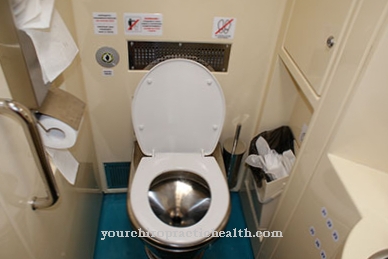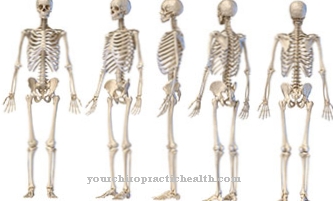To be a prisoner of one's own body - a terrible idea that the Locked-in syndrome (in German: Trapped Syndrome or Trapped Syndrome) oppressive truth becomes. The most well-known, media-present example of today is probably Stephen Hawking.
What is locked-in syndrome?

© designua - stock.adobe.com
At the Locked-in syndrome it is a complete paralysis of the four limbs and the body, as well as the speech apparatus, which leads to an almost complete loss of the ability to communicate with the environment.
Those affected can usually only communicate via eye movements (blinking, blinking, etc.), but even in this way only very limited statements are possible through yes / no questions (or and / or questions).
If this possibility of understanding is also developed, help can only be provided by technical means in order to continue to maintain active contact with the outside world.
However, it should be noted that this disease is by no means a comatose state, as the patient has his entire consciousness, i.e. can hear, see and understand his environment.
causes
The most common cause of this paralyzing disease is brain stem infarction. The blood supply to the midbrain, brain bridge and elongated spinal cord is so severely restricted or sometimes completely interrupted that there are significant restrictions in various body functions.
Other common causes are meningitis (inflammation of the meninges), special nerve diseases (e.g. amyotrophic lateral sclerosis), strokes, and severe trauma and accidents. Locked-in syndrome can be observed more rarely in patients with multiple sclerosis, inflammation of the arteries / nerves or after the abuse of toxic substances / drugs (heroin).
Symptoms, ailments & signs
The locked-in syndrome is associated with an intact state of consciousness with an almost complete inability to act. Affected people perceive stimuli. So you can hear, smell, taste, see and also (restricted) feel. Speech comprehension is usually not restricted.
The paralysis that occurs in locked-in syndrome involves the four extremities and horizontal gaze movements. In most cases, the ability to speak, swallow, and facial expressions is lost. So there are only vertical eye movements for communication. If these fail, at least the mechanisms for dilating the pupils are still intact. Overall, the physical situation from the neck down can be compared with the situation of a completely paraplegic.
Those affected are not restricted in their wakefulness. In the broadest sense, you experience a normal biorhythm. There is hardly any perceived pain or an uncomfortable body feeling. There is awareness of one's own paralysis. The cognitive possibilities are usually only limited to the extent that the trigger of the locked-in syndrome can lead to cognitive limitations.
Due to the fact that the patients are mostly fully conscious, the locked-in syndrome must be differentiated from the vegetative state. In this case, it must be questioned whether and to what extent those affected perceive their surroundings.
Diagnosis & course
Diagnosing one LiS can not be determined by pure "inspection", since the clinical picture shows a lot of similarity to the vegetative state or akinetic mutism (a disease that is mainly characterized by a severe drive disorder).
Suitable diagnostic methods are mainly electrical and magnetic measurements of brain and muscle activity. Changes in blood flow and metabolism of the brain can thus be determined using CT and MRI. In most cases, these technical diagnostic methods are combined with laboratory techniques, for example to better assess an inflammatory condition in meningitis.
The course of this disease is very individual and depends on both his medical care and the cause of the outbreak. It can be assumed that there is a mortality of 59-70% if the LiS was triggered by a bleeding or blockage in brain vessels. For trauma, tumors, etc. this rate drops to about 30%. Illnesses caused by toxins (poisons / drugs) almost never lead to death.
Complications
As a rule, those affected by the locked-in syndrome suffer from considerable psychological complaints and complications. However, you cannot express yourself or communicate with the outside world. This results in significant and significant restrictions in the everyday life of the person affected. With locked-in syndrome, the patients themselves usually suffer from paralysis and are therefore dependent on the help of other people in their everyday lives.
This often results in restricted mobility, so that the patients are dependent on a wheelchair. Because of the speech disorders, there is usually no communication with the outside world. The affected person is in a vegetative state and suffers from severe depression and other mental disorders.
In most cases, the patient's life expectancy is not restricted by the locked-in syndrome. However, the further course depends heavily on the cause of the locked-in syndrome, so that a general course of the disease cannot be predicted. A causal treatment of locked-in syndrome is usually not possible.
Those affected are dependent on various therapies and aids in everyday life. Usually the syndrome cannot be completely cured either. The patient’s relatives in particular suffer from severe depression and other psychological limitations as a result of the syndrome.
When should you go to the doctor?
By definition, locked-in syndrome prevents those affected from going to the doctor themselves. However, the worrying symptoms in any case lead to the sick person ending up in a hospital. Since a stroke is the most common trigger of locked-in syndrome, post-incident medical surveillance usually results.
In general, those affected by locked-in syndrome do not have the option of foregoing medical attention. This is because the condition urgently needs to be differentiated from other conditions of inability to move and appropriate care and supervision must be provided. Since the person affected cannot communicate effectively and the symptoms of the suffering can be so easily confused, it is sometimes up to the relatives to point out the possibility of a locked-in syndrome.
Since the disease requires a great deal of medical attention, neurologists are particularly important in the further course to check the functionality of the body. For the course of a possible recovery it is important that the physiotherapeutic, speech therapy, occupational therapy and, if necessary, psychotherapeutic treatment is optimally covered by specialists.
Treatment & Therapy
Treatment of those affected requires one thing in the first place: An intensive and individual combination of occupational therapy, speech therapy and physiotherapy. The main goal is to mobilize the patient and thus release him from his inability to move. The sooner such rehabilitation is scheduled, the more likely it will be a success.
In physiotherapy today, the principle of "systematic repetitive basic training" is mainly used. This includes that initially only individual, small movements on the joints are trained. If these can be carried out independently again and certain positions can be held, the training exercises are extended to several joints and muscle groups and then carried out in precise activities (for example, holding a fork and bringing it to the mouth).
Occupational therapy offers further assistance in relearning various skills. in the reconstruction of fine and gross motor skills. Other areas of responsibility are the improvement of communication (via body language), the development of socio-emotional abilities (showing emotional states) but also the assistance with possible renovations in the home environment and the acquisition of suitable aids.
The use of speech therapists as the third pillar of therapy is primarily used for swallowing training in order to enable independent food intake again. Frequent, targeted exercises should also restore an improvement in language skills in order to achieve more active communication with the patient environment.
Outlook & forecast
The prognosis for locked-in syndrome is usually poor. In most cases the symptoms last for life or show only slight improvement over the life span. Achieving full recovery is rare. Nevertheless, the course of the disease depends on the cause of the disorders. If there is a way to correct the causal triggers, a cure can ensue.
Various therapies are used to support the quality of life and promote well-being. These are individually adapted to the possibilities of the organism and often vary over time. Locked-in syndrome involves long-term treatment of the patient. Without the use of medical care, the status quo is at best maintained. In an unfavorable case, the affected person dies prematurely.
Many sufferers report an improvement in their quality of life when they carry out targeted exercises and training independently and on their own initiative outside of the therapy options offered. However, most patients are dependent on the help of other people for life. It is usually not possible for them to cope with their everyday life without full-time care. The physical impairment can lead to psychological complications. The disease represents a strong emotional burden for the person concerned but also for the relatives.
prevention
There are no special measures to avoid illness. A healthy lifestyle without toxins such as alcohol, nicotine (and the accompanying substances contained in cigarettes) as well as drugs of any kind can cause causes such as strokes and the like. minimize, but this is no guarantee.
Aftercare
Since the locked-in syndrome usually does not heal itself, aftercare primarily focuses on managing the severe restrictions in movement. Most of those affected depend on help and support from family and friends in their everyday lives. The ability to speak can also be restricted, so that those affected can no longer speak properly and can no longer ingest food themselves.
Since the disease often leads to psychological complaints, it can be helpful if those involved, including relatives, seek professional psychological help. The exchange with other affected persons in self-help groups can also result in an exchange of valuable information and self-confidence in dealing with the disease.
You can do that yourself
The symptoms that people with locked-in syndrome can take to improve their situation are limited. Until the start of a suitable therapy that enables at least partial movements and partial movement sequences, those affected - with the exception of the possibility of communication - are completely dependent on their environment.
With the start of therapy, it is also up to the person concerned to consistently incorporate exercises that can be carried out alone or in a private environment into their daily planning.This is especially true when the inpatient stay is ended, as this usually also means a reduction in therapy hours.
For those affected, the situation means that they also have to learn certain forms of communication. Due to the restrictions, it becomes necessary to adapt the communication in order to stay in contact with the person concerned. At the same time, speaking should not be overly simplified - just like a small child, for example - because locked-in syndrome patients seem objectively helpless, but their perception is usually not restricted. It is also up to relatives to support the care of the person concerned. This includes visits, specially performed hand movements (if permitted) and of course checking for possible bedsores or poor posture.
Further measures that can be taken by the person affected and their environment are very much dependent on the possible success of the therapy and the delayed effects of the locked-in syndrome. Accordingly, they should be worked out together with doctors and therapists.

.jpg)
.jpg)





















.jpg)



